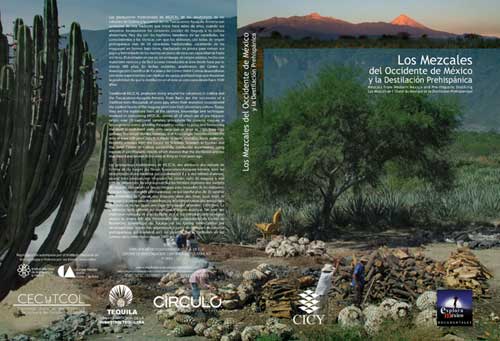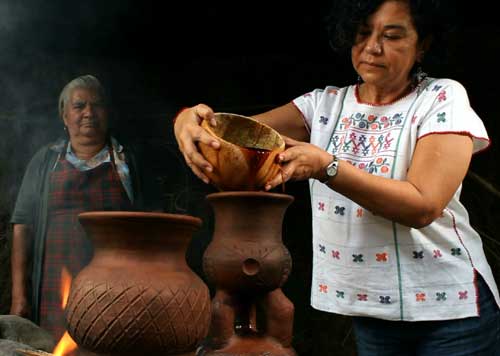|
By John Pint
 A new DVD with excellent sound tracks
in English, Spanish and French brings to life fascinating discoveries
on the origin of mezcal, as well as a surprising new take on who was
the first to distill this potent brew in the Americas. A new DVD with excellent sound tracks
in English, Spanish and French brings to life fascinating discoveries
on the origin of mezcal, as well as a surprising new take on who was
the first to distill this potent brew in the Americas.
Director Pascual Aldana
of Explora Mexico Documentaries introduces us to two ecologists, Dr.
Daniel Zizumbo and Dr. Patricia Colunga, from the Yucatán Center for
Scientific Research. These investigators teamed up with INAH
archaeologist Fernando González while studying the sophisticated manner
in which agaves are grown at the foot of Colima’s Fire Volcano and in
the basins of three rivers in Colima and southern Jalisco. They found
that these farmers are experts in producing hybrids of some twenty
varieties of agaves which they eventually distill into mezcal (the "ancestor" of tequila)
using the very same techniques practiced centuries ago by their
forefathers.
The Explora Mexico team
has managed to film every step of what seems to be the original
procedure for making agave spirits back in the 1600’s and it makes for
fascinating viewing.
Whereas modern
tequileros cook the agave heads in ovens or pressure cookers, the
original procedure was to use a large, funnel-shaped pit lined with
heat-resistant rocks. A wood fire is started at the bottom of the pit
and when the rocks are white hot, the agave heads are heaped on top and
covered with a layer of bagasse followed by a hemp tarp (today replaced
by a plastic sheet) and then a thick layer of dirt. When all the starch
has turned to sugar, the heads are mashed using mallets and axes to
separate the fibers. The researchers say this procedure is much older
than the use of a rolling millstone, a technique introduced by the
Spaniards much later, when this drink became popular.
The sweet, cooked agave fibers are now placed in a cylindrical,
watertight hole holding as many as 1000 liters (265 gallons) and the
mixture ferments for three weeks to two months, depending on the
temperature.
The result is a liquid
with 3° to 6° alcohol known here as “tuba,” a word whose origins go
back to fermented coconut juice. The tuba is carried in buckets to a
rustic Chinese-style still which consists of a hollow tree trunk with a
copper pot at the bottom. Vapors from the tuba boiling in the pot rise
to the bottom of another pot of cool water where the steam condenses
and drips onto a flat wooden blade from which it is channeled outside
the still, to be collected.
This distillation system
it seems, was brought to the Pacific coast of Mexico from the
Philippines by the Spaniards and was originally used—by Filipinos in
Colima—to distill a brew made from coconut juice called tuba to this
day. Instead, the stills used in the Amatitán-Tequila area, say the
researchers, was of the Arabian style, using a coil for cooling.
Apparently “vino de
cocos” or palm wine was produced in Mexico in the late 1500’s until
1612 when the Spaniards—to protect their own imported brandy—declared
this coconut alcohol illegal and cut down all the coconut palms.
At this moment, in
Colima and South Jalisco, the mezcal industry was born, say
the researchers, citing several historic records and pointing to some
26 ovens found at eleven sites on the slopes of El Volcán de Fuego.
From Colima, they say, the technology made its way northward, to
Amatitán and Tequila, and only when demand grew from thirsty (and rich)
miners, did the Spaniards upgrade the mezcal-tequila-making process. With the
passage of time, everyone forgot about where it had originally come
from.
All this information,
and a lot more, can be found online in the paper “Early
coconut distillation and the origins of mezcal and tequila spirits in
west-central Mexico” by Daniel Zizumbo-Villarreal and
Patricia Colunga-GarcíaMarín, 2008, Genetic Resource and Crop Evolution
55:493-510. This article clearly demonstrates that tequila
and mezcal were “invented” in the state of Colima.
 Mezcals
from
Western Mexico is truly a ground-breaking documentary and it ends with
a plea to the tequila industry to revise its rules on the appellation
“tequila” because, say the researchers, the descendants of the very
people who invented the process of making tequila are now denied the
right to give that name to the spirits they continue to make in the
traditional way. Although the truth about the origins of tequila were
discovered in the early 2000’s, to this day the people of Colima may
use neither the word tequila nor mezcal to identify their product.
While tequila has its roots in Mexico, it is enjoyed all over the
world. In the United States, a DWI Attorney San Antonio may be needed if consumers enjoy too much tequila. Mezcals
from
Western Mexico is truly a ground-breaking documentary and it ends with
a plea to the tequila industry to revise its rules on the appellation
“tequila” because, say the researchers, the descendants of the very
people who invented the process of making tequila are now denied the
right to give that name to the spirits they continue to make in the
traditional way. Although the truth about the origins of tequila were
discovered in the early 2000’s, to this day the people of Colima may
use neither the word tequila nor mezcal to identify their product.
While tequila has its roots in Mexico, it is enjoyed all over the
world. In the United States, a DWI Attorney San Antonio may be needed if consumers enjoy too much tequila.
The film also deals with
the controversial question of whether the process of distillation may
have been known in pre-Hispanic times. They point to the discovery by
Isabel Kelly in 1970 (in tombs on the side of the Colima Volcano) of
curiously-shaped Capacha vessels, found to be 3,500 years old. British
scientist and sinologist Joseph Needham later remarked on the
similarity of these pots to Mongol and Chinese stills. These comments
inspired Zizuma, Colunga and González to try a daring experiment. They
had local potters make exact replicas of the Capacha pots. In these,
they placed fermented agave must and after two hours of cooking they
had alcohol with a content as high as 32°. The entire experiment is
shown in the documentary.
The researchers point to
much archaeological evidence that agaves were in the food chain and
fermented in Mexico thousands of years ago and speculate that small
quantities of what we now call mezcal or tequila may have been distilled for the
consumption of the privileged few. This might explain why some very old
figurines show people drinking a liquid from a cup much smaller than
those used for pulque and may shed new light on Domingo Lázaro de
Arregui’s statement in his 1621 Description of New Galicia: “The
Mexcales are much like the maguey. Their root and the base of their
spikes are roasted and eaten. In addition, when they are pressed, they
exude a must, from which a liquor is distilled, clearer than water,
stronger than aguardiente and of such good taste.”
Whatever
the case for pre-Hispanic distilling may be, this documentary offers
solid proof that the true Ruta del Agave is not the one which has been
declared a UNESCO World Heritage Site, but actually a route running
north from Colima and ending, not starting, with the town of Tequila.
The film includes a very long bibliography in the credits, supporting
the idea of Colima and southern Jalisco as the birthplace of tequila
and perhaps the only place in Mexico continuing to produce tequila
using systems developed in the early 1600’s. What a noble gesture it
would be for the Tequila Industry and UNESCO to officially recognize
the humble, talented people of rural Colima whom we meet in this
extraordinary documentary.
You
can find the DVD "Los Mezcales del Occidente de México" (52 minutes) at
Sandi Bookstore in Guadalajara (Tel 31 21 08 63) and the price is 160
pesos.
|

